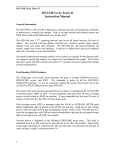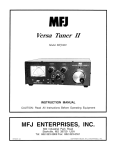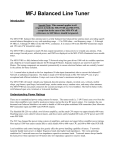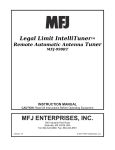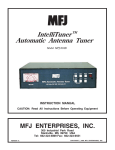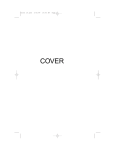Download MFJ 945D Instruction manual
Transcript
MFJ-945D Instruction Manual MFJ-945D Mobile Tuner Instruction Manual Introduction The MFJ-945D tuner is a 300 watt PEP output (175 watts on 160 m) antenna tuner. It is designed to match 50 ohm output amplifiers, transmitters or transceivers to an antenna in a mobile installation. Forward power, reflected power, and SWR are displayed on the wattmeter's illuminated cross-needle meter. The MFJ-945D uses a "T" matching network. It continuously tunes all frequencies from 1.8 through 30 MHz. It will match dipoles, inverted-vee's, verticals, mobile whips, beams, random wires, and many other antennas. The MFJ-945D has a single connector for coaxial output. SWR/Wattmeter The cross-needle meter measures the peak or average FORWARD power, REFLECTED power, and SWR. The meter's full scale forward and reflected power range is controlled by the left POWER switch that selects 300W (HI) or 30W (LO). If your transmitter runs more than 30 watts of output power, set this switch to the 300W HI (in) position. If your transmitter has less than 30 watts of output, set this switch to the 30W LO switch position (out). Forward power is displayed on the left-hand FORWARD meter scale. This scale is calibrated from 0 to 30 watts and is read directly in the 30 watt position. In the 300W (HI) position the forward power scale must be multiplied by 10. Reflected power is read on the right-hand REFLECTED meter scale. This scale indicates 5 watts full scale when the 30W power sensitivity is selected, and 50 watts full scale when the 300W power scale is selected. This scale is also multiplied by 10 when using the 300W power position. The most accurate power readings occur in the upper half of the meter scales. When trying to measure power with a less than perfect match, the reflected power should be subtracted from the forward power readings. The SWR is read directly from red SWR curves that range from 1:1 to infinity. SWR is measured by observing the point where the forward and reflected power needles cross. The SWR is indicated by the red curve closest to the needle crossing point. No cumbersome or time consuming SWR sensitivity adjustments are required with this meter. The wattmeter has an internal lamp that backlights the meter scale. The lamp circuit requires power from an external 12 Vdc source. The rear panel jack accepts a 2.5 mm plug with a positive tip polarity. The negative lead is grounded inside the tuner. The METER LAMP ON / OFF switch turns the meter lamp off and on. 1 MFJ-945D Instruction Manual Interconnections 2 MFJ-945D Instruction Manual Installation SAFETY NOTE: LOCATE THE TUNER SO THE REAR IS NOT ACCESSIBLE DURING OPERATION. 1. Locate the tuner in a convenient location at the operating position. 2. Install the tuner between the transmitter and the antenna as shown in the diagram at left. Use a coaxial cable (such as RG-8/U) to connect the transmitter (or amplifier) to the connector marked TRANSMITTER on the rear of the tuner. 3. Use a coaxial cable (such as RG-8/U) to connect the connector marked ANTENNA on the rear of the tuner to the antenna. If use of more than one antenna is required, install a coax switch between the tuner and the antennas. For wire antennas an appropriate balun should be used between the coax from the tuner to the wire feed to the antenna. 4. A ground post is provided for an RF ground connection. Using The MFJ-945D CAUTION: Never Change The Antenna or Inductor Selector Switch Position While Transmitting! Never Apply More Than 300 Watts To The MFJ-945D. In any conventional "T" network tuner, maximum power handling and smoothest tuning occur when the capacitance in the network is as large as possible. In this tuner the TRANSMITTER and ANTENNA controls have maximum capacitance at position 0 (fully meshed), and minimum capacitance at position 10 (fully open). Use the highest capacitance possible (lowest number on the front panel scale) for each band for the smoothest tuning, highest efficiency, and greatest power handling capability. The chart in the tuning instructions shows typical capacitor settings that can be used for each amateur band. 3 MFJ-945D Instruction Manual The INDUCTANCE switch in the MFJ-945D has maximum inductance in position "A", and minimum inductance in position "L". The chart in the tuning instructions shows typical INDUCTANCE switch settings for each amateur band. Less inductance is needed as the frequency is increased. If too little inductance is used, the tuner may not match the load properly. If too much inductance is used, the tuner will be "touchy" and power handling will be compromised. Most modern solid state transceivers do not require tuning and loading adjustments. If the transceiver has a built in antenna tuner, be sure it is turned off or disabled. If your transmitter has an adjustable output circuit, it must be properly tuned to a 50 ohm load at the operating frequency before adjusting the tuner. This should be done with a dummy load. If you do not have a dummy load, use the recommended maximum transmitter load setting and "dip" the plate. Note: Do NOT change the transmitter's tuning (plate) or loading (antenna) controls until after the tuner has been fully adjusted. The transmitter can be "touched up" after the MFJ-945D is fully tuned. Set the GROUND MATCHING controls at zero (maximum capacitance) and "L" (minimum inductance) unless you already know the correct position for the band you are using. Ground matching is done after the tuner is adjusted for lowest SWR. Adjustment Procedure When using the MFJ-945D for receiving only, simply adjust the MFJ-945D for the highest "S" meter or signal level. The Tuning Chart can be used as a reference. WARNING: It is unsafe to adjust this or any tuner in heavy traffic. MFJ suggests that before adjusting this tuner, the user pull over on a median or sidewalk to make any adjustments. Even though our advertising suggests that the front panel controls are easy to adjust while a vehicle is in motion, to do so in heavy traffic (such as in Conyers, a subburb of Atlanta) would surely result in serious injury or even amputation. 1. Select the 30W (out) METER switch scale. Turn the transmitter's power control fully down. 2. Position the TRANSMITTER and ANTENNA MATCHING controls and the INDUCTOR SELECTOR switch in the bottom Tuning Chart position for the operating frequency. 3. Apply just enough power on CW (or AM / FM / RTTY) to obtain noticeable deflection on the reflected power meter. 4 MFJ-945D Instruction Manual 4. Carefully adjust the "TRANSMITTER" and "ANTENNA" MATCHING controls for the lowest reflected power. NOTE: These controls interact. Adjust the TRANSMITTER control for minimum, then adjust the ANTENNA control for minimum SWR. Go back and forth between these adjustments as many times as required until the lowest reflected power (best SWR) is obtained. Tuning Chart Frequency MHz 1.8 1.8 2.0 2.0 3.5 3.5 3.5 3.75 3.75 3.75 4.0 4.0 4.0 7.15 7.15 10.1 10.1 14.2 18.1 18.1 21.2 21.2 24.9 28.5 Transmitter Inductor Antenna 4-1/2 1 5-1/2 3 9 6 4 7 5 3 7 6 4 8 6 9 8 9-1/2 9-1/2 8-1/2 9-1/2 7 9 9-1/2 A B A B B C D C D E C D E F G G H H I J J K K K 4-1/2 1 5-1/2 3 9 6 4 7 5 3 7 6 4 8 6 9 8 9-1/2 9-1/2 8-1/2 9-1/2 7 9 9-1/2 5. If a perfect or very low SWR can not be obtained, stop transmitting. Increase the INDUCTOR SELECTOR control (higher letter) and decrease the capacitance (lower number). Try the row of chart settings just above the last one tried. Repeat from Step 3. NOTE: If an SWR of 1:1 can not be obtained, move the switch towards the end of the alphabet one position at a time. Repeat Steps 3 and 4 for each new INDUCTOR switch position. Always use the highest alphabetical setting possible. 5 MFJ-945D Instruction Manual WARNING: Never transmit while changing the INDUCTOR SELECTOR. 6. Increase the transmitter power until the Forward power level is full scale (30 watts) and observe the reflected power or SWR. If the reflected power and SWR are not satisfactory, adjust the MATCHING controls again. NOTE: If your transmitter will not put out 30 watts, set it to the maximum power available. 7. After a low SWR is obtained, the transmitter power may be increased to any value up to 300 watts carrier, or 300 watts PEP (175 watts on 160 meters). The MFJ-945D will reduce the SWR of most antenna systems to 1:1. In some cases, a perfect 1:1 SWR may not be obtainable. If this is the case, the length of the antenna or the feedline can be changed slightly until a low SWR can be obtained. See the antenna hints section. In Case Of Difficulty If this tuner fails to tune, please double check all connections and follow the tuning procedures again. Be sure you are using enough inductance (highest letter usable for band) and have the capacitors open far enough (highest front panel number). The power rating of this tuner is 300 watts on 80 meters and above, and 175 watts on 160 meters. If this tuner arcs at the rated power levels, please double check all connections and follow the tuning procedures again. Be sure you are using the highest inductance letter and the lowest capacitance number possible to match the load on the operating frequency. If you are still unsuccessful, but the tuner does adjust and operate when connected to a dummy load or another antenna, please read the following ANTENNA HINTS text. Grounding Hints To minimize RFI, single wire feedlines (such as used with Windom or longwire antennas) should be kept away from other wiring. Radiation will be minimized if the single wire feeder runs parallel and reasonably close to the wire that connects the tuner to the outdoor ground. The antenna feed wire should be adequately insulated to prevent arcing or accidental contact. For safety, please use both dc and RF grounds. It is particularly important to have a good RF ground while using a single wire feeder. When using a single wire feeder, the tuner needs something to "push" against in order to force current into the line. If a good RF ground is not available, RF will usually find it's way back into the power line (RFI), transmitter audio circuits (RF feedback), or the operator (RF burns). 6 MFJ-945D Instruction Manual Water pipes provide good dc and ac safety grounds, but they are often inadequate for RF grounding because they are long single conductors. RF grounds require large "spread out" surfaces with direct multiple connections to the equipment ground point. Water pipes, heating ducts, or multiple ground rods may work (especially if they are all connected together with jumper wires), but the best RF grounds are radial systems or multi-wire counterpoises. RF and lightning travels on the surface of conductors. Braided or woven conductors have high surface resistance to lightning and RF. Ground leads for RF should have wide smooth surfaces. Avoid the use of woven or braided conductors in RF and lightning grounds unless the lead needs to be flexible. Antenna System Hints For operator safety a good outside earth ground or water pipe ground should always be installed and connected to the case of the MFJ-945D. Make certain the safety ground also connects to the transmitter and other station accessories. A wing nut post marked GROUND is provided for ground connection(s). Location For the best performance, an end-fed longwire wire antenna should be at least one quarterwavelength long at the operating frequency. Horizontal antennas should be at least a half wave long and high and clear of surrounding objects. While good RF grounds help the signal in almost any transmitting installation, it is extremely important to have good RF grounds with long wire or other Marconi style antennas. Matching Problems Most matching problems occur when the antenna system presents an extremely high impedance to the tuner. When the antenna impedance is much lower than the feedline impedance, an odd quarter-wavelength feedline converts the low antenna impedance to a very high impedance at the tuner. A similar problem occurs if the antenna has an extremely high impedance and the transmission line is a multiple of a half-wavelength. The half-wavelength line repeats the very high antenna impedance at the tuner. Incorrect feedline and antenna lengths can make an otherwise perfect antenna system very difficult or impossible to tune. One example where this problem occurs is on 80 meters when an odd quarter-wave (60 to 70 foot) open wire line is used to feed a half-wave (100 to 140 foot) dipole. The odd quarter-wave line transforms the dipole's low impedance to over three thousand ohms at the tuner. This is because the mismatched feedline is an odd multiple of 1/4 wavelength long. The line inverts (or teeter-totters) the antenna impedance. A problem also occurs on 40 meters with this same antenna example. The feedline is now a multiple of a half-wave (60 to 70 foot) and connects to a full-wave high impedance antenna (100 to 140 foot). The half-wave line repeats the high antenna impedance at the tuner. The antenna system looks like several thousand ohms at the tuner on 40 meters. 7 MFJ-945D Instruction Manual This places enormous strain on the balun and the insulation in the tuner, since voltages can reach several thousand volts. This can cause component arcing and heating. The following suggestions will reduce the difficulty in matching an antenna with a tuner: 1. Never center feed a half-wave multi-band antenna with a high impedance feedline that is close to an odd multiple of a quarter-wave long. 2. Never center feed a full-wave antenna with any feedline close to a multiple of a half-wave long. 3. If this tuner will not "tune" a multi-band antenna, add or subtract 1/8 wave of feedline (for the band that won't tune) and try again. 4. Never try to load a G5RV or center fed dipole on a band below the half-wave design frequency. If you want to operate an 80 meter antenna on 160 meters, feed either or both conductors as a longwire against the station ground. To avoid problems matching or feeding any dipole antenna with high impedance open wire lines, keep the lines around these lengths. The worst possible line lengths are shown in brackets: 160 meter dipole; 35-60, 170-195 or 210-235 feet. (Avoid 130, 260 ft) 80 meter dipole; 34-40, 90-102 or 160-172 feet. (Avoid 66, 135, 190 ft) 40 meter dipole; 42-52, 73-83, 112-123 or 145-155 feet. (Avoid 32, 64, 96, 128 ft) Some slight trimming or adding of feedline may be necessary to accommodate the higher bands. WARNING: To avoid problems, a dipole antenna should be a full half-wave on the lowest band. On 160 meters, an 80 or 40 meter antenna fed the normal way will be extremely reactive with only a few ohms of feedpoint resistance. Trying to load an 80 meter (or shorter) antenna on 160 meters can be a disaster for both your signal and the tuner. The best way to operate 160 meters with an 80 or 40 meter antenna is to load either or both feedline wires (in parallel) as a longwire. The antenna will act like a "T" antenna worked against the station ground. Technical Assistance If you have any problem with this unit first check the appropriate section of this manual. If the manual does not reference your problem or your problem is not solved by reading the manual you may call MFJ toll-free at 1-800-647-TECH (8324). Outside of the continental USA. call 601-323-5869. You will be best helped if you have your unit, manual and all information on your station handy so you can answer any questions the technicians may ask. 8 MFJ-945D Instruction Manual You can also send questions by mail to MFJ Enterprises, INC., PO. Box 414, Mississippi State, MS 39762; by FAX to 601-323-6551; through Compuserve at 76206.1763; or by email to [email protected]. Send a complete description of your problem, an explanation of exactly how you are using your unit, and a complete description of your station. Schematic 9









